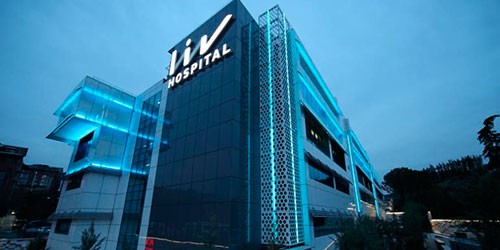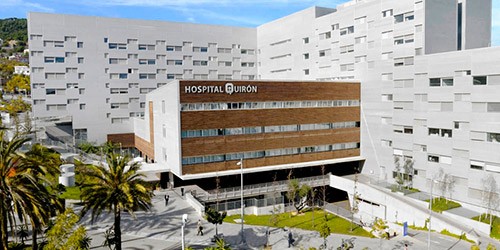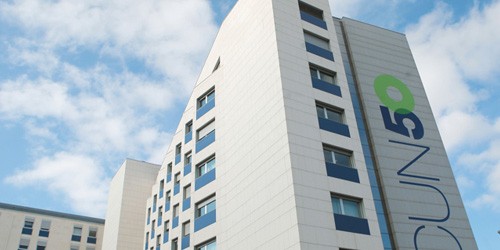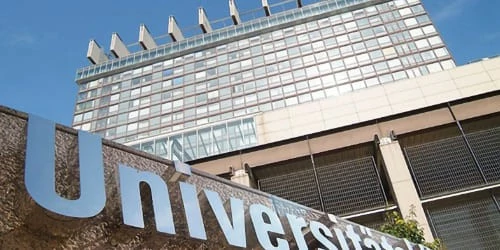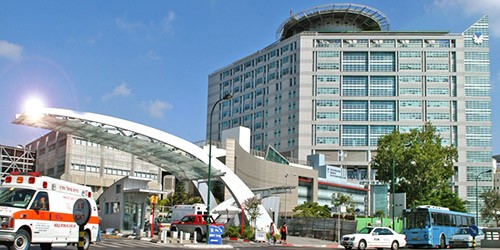Acute monoblastic leukaemia is a rare form of blood cancer that requires long and aggressive treatment. The disease occurs in children and adults over 40 years of age. It accounts for 18% of all paediatric acute leukaemia cases. The most favourable prognosis in acute monoblastic leukaemia is seen when the diagnosis is timely and the treatment plan is appropriate. Read our article about what modern treatment options are available for patients abroad.
What is acute monoblastic leukaemia?
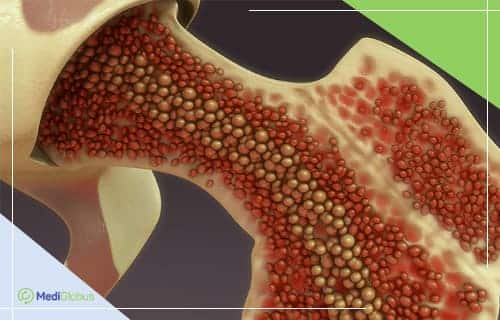
Acute monoblastic leukaemia (AML-5, M5) is a type of blood cancer – a malignant disease that affects the bone marrow. An overproduction of monocytes (the cells of the bone marrow) occurs due to a cell mutation. It causes many health complications for the patient.
The disease is malignant, which means it can spread through the body and form foci in other organs.
Acute monoblastic leukaemia is a rare type of cancer. This means that it is less well-studied than other forms of bone marrow cancer. For the treatment of AML-5, you should go to experienced clinics with strong departments of oncology and research medicine. They can usually offer more effective cancer treatments and the opinions of the country’s foremost experts in haemato-oncology.
The main criterion for M5 that distinguishes it from other leukaemias is the increased production of cancerous monocytes in the blood. These are immune cells that help the body fight infections and diseases. However, in acute monoblastic leukaemia, cancer mutations disrupt the monocytes, making them unable to perform their protective function. More than 80% of a person’s immune cells get replaced by defective cells.
Acute monoblastic leukaemia occurs in both children and adults. Half of the cases of paediatric AML-5 are diagnosed in children under 2 years of age. Among adult patients, the disease is more common in men over the age of 40.
The exact causes of acute monoblastic leukaemia have not been identified. Risk factors include:
chemotherapy, in particular, treatment with anthracyclines and epipodophyllotoxins;
genetic predisposition;
exposure of the foetus to pesticides and marijuana during pregnancy.
Acute monoblastic leukaemia is divided into two subtypes: AML M5a and AML M5b.
Acute monoblastic leukaemia M5a
The AML subtype M5a is the more common. It usually occurs in children and young adults. A biopsy of the bone marrow of these patients reveals that most of it is replaced by cancerous monoblasts. The doctor will be able to notice their visual differences from healthy cells and also detect genetic mutations.
Acute monoblastic leukaemia M5b
AML M5b is less common than M5a. In this subtype, bone marrow cells are replaced by promonocytes (immature immune cells with gene mutations). Mature monocytes aka promonocytes are found in the blood of such patients. Treatment of M5b acute monoblastic leukaemia can lead to increased platelet counts or tumour decay syndrome.

GET A SECOND OPINION
Foreign oncologists offer online consultations. Leading experts in the field of leukaemia treatment can review the results of your examinations and recommend the best course of treatment. To contact an experienced blood cancer specialist, leave your request online by clicking on the button below.
What are the symptoms of acute monoblastic leukaemia?
Acute monoblastic leukaemia has a specific set of symptoms:
Hyperleukocytosis – increased number of immature blood cells;
General physical and mental weakness;
Pallor, fever, dizziness;
Neurological symptoms – headaches, nausea and vomiting, irritability, drowsiness;
Dense tumours;
Blood clotting;
Skin rashes;
Soreness and swelling of the gums.

Some of these symptoms are more common in acute monoblastic leukaemia than in other types of blood cancer. However, they may also indicate the presence of other diseases. Also, not every patient will have all the symptoms. A doctor should be consulted if there are any unexplained changes in the body to make a correct diagnosis.
How is acute monoblastic leukaemia diagnosed?
The main methods of diagnosing AML-5 are blood tests and bone marrow biopsies. They are used to measure the number of cells in the tissue samples and compare them with normative data. In all blood cancers, there are changes in cell shapes and an increase in the number of immature lymphocytes. However, acute monoblastic leukaemia has a specific blood pattern that distinguishes it from other diseases.
For a diagnosis of M5 acute monoblastic leukaemia, patients must have all of the following:
80% of bone marrow cells are monoblasts, monocytes and monocytes;
The presence of up to 20% granulocytes;
More than 80% of monoblasts or more than 80% of promonocytes among monocytes in the bone marrow;
Intense non-specific esterase activity inhibited by sodium fluoride;
Monocyte count in the blood test exceeds 5 × 103/l;
Immature cells account for 30% or more of the bone marrow.

TREATMENT APPOINTMENT
Foreign clinics offer modern treatments for leukaemia, often unavailable in countries with less-developed medicine. To take advantage of this opportunity and get fast access to quality treatment, leave your request by clicking on the button below.
How is acute monoblastic leukaemia treated?
Chemotherapy
Acute monoblastic leukaemia requires rapid and aggressive treatment. Chemotherapy is used first. Patients usually receive 4-6 courses of combined drugs at intervals of 3-4 weeks. The chemo can be given intravenously or in tablet form. To control side effects, supportive therapy is always implemented to ease the patient’s condition for the duration of the treatment.
Chemotherapy for acute monoblastic leukaemia is usually given in three stages:

Induction – a short, intensive course of medication that kills most of the leukaemic cells in the blood;
Consolidation – a long cycle of intermittent chemo that is carried out to destroy any residual cancer cells;
Maintenance – a course of low-dose chemotherapy that lasts for months or years to maintain remission or stabilise the disease.
Aggressive chemotherapy protocols can cause dangerous complications. This is why such therapy is always carried out under close medical supervision. Additional medication is prescribed to prevent dangerous symptoms. Oncotherapy often causes anaemia, neutropenia or thrombocytopenia – a decrease in the level of various blood cells.
Patients with M5 acute monoblastic leukaemia usually suffer from a weakened immune system, which can worsen during treatment. To prevent infections, these cancer patients may be hospitalised in sterile boxes and given antibiotics and antifungal drugs. Such therapy is given both during and after cancer treatment.
Targeted therapy
Targeted therapy is one of the most advanced cancer treatments. These drugs target cancer cells without affecting healthy organs. Targeted therapy, therefore, does not cause severe side effects like other cancer therapies. In acute monoblastic leukaemia, targeted therapy is given in addition to chemotherapy.
The selection of targeted therapy drugs depends on the presence of specific gene mutations in the malignant cells. Genetic analysis of blood tissue or bone marrow is carried out to identify these.
The following groups of targeted drugs can be used to treat acute monoblastic leukaemia:
FLT3 inhibitors;
IDH inhibitors;
BCL-2 inhibitors;
Hedgehog pathway inhibitors;
Monoclonal antibodies.
Radiation therapy
Radiation therapy is often used in the treatment of acute monoblastic leukaemia to prevent CNS recurrence. Radiation is also used to treat dense tumours, metastases and before a bone marrow transplant. In many cases, however, doctors give preference to chemotherapy because it works faster.

Bone marrow transplants
Sometimes doctors may use a bone marrow transplant to be able to prescribe higher doses of chemotherapy. This allows for more efficient destruction of cancer cells that can resist conventional treatment protocols.
Together with the malignant cells, high doses of chemotherapy destroy the bone marrow. To restore it, doctors inject blood-forming stem cells into patients’ blood.
During treatment, the patient’s body is unable to produce blood cells on its own and remains vulnerable to infection and injury. For this reason, patients are rehabilitated for 1-3 months in sterile rooms with HEPA filters until their blood counts normalise.
The most common treatment for acute monoblastic leukaemia is allogeneic bone marrow transplantation from a donor. Genetic relatives, such as siblings, are best suited to this role. If no suitable candidates are found among relatives, doctors turn to bone marrow donor banks. Most countries have national databases, from which they look for genetically compatible people who are willing to become donors. Foreign clinics have access to international donor banks, which increases the chance of finding a suitable candidate. Most MediGlobus patients who come to us for a bone marrow transplant can find a donor within 2-3 weeks.
Prognosis of patients with acute monoblastic leukaemia
The prognosis for acute monoblastic leukaemia is the same as for other types of myeloid leukaemia. On average, 52% of patients with the M5a subtype and 65% of those with the M5b subtype achieve remission. However, there is a high risk of relapse. Certain genetic cell mutations, such as chromosomes 16, 8 and 21, are associated with better treatment prospects. Younger people also have a better prognosis.
The story of a patient with acute monoblastic leukaemia
Hayley was diagnosed with acute monoblastic leukaemia at the age of 19 after a routine procedure – a wisdom tooth extraction – caused a severe infection. The girl was hospitalised with very low blood counts: 5 g/dl haemoglobin while the norm is 14-17,5, and her white blood cell count was three times higher. A biopsy showed that Hayley’s bone marrow was 95% replaced by cancer cells. This meant that AML-5 had managed to reach a severe stage.
Two days after the diagnosis, the doctors started treatment. She first underwent two cycles of intensive chemotherapy. She was treated in the hospital for another ten weeks until her blood count finally began to normalise. This was a sign that the disease had begun to recede.
However, the danger was still not completely gone – acute monoblastic leukaemia often returns even after successful treatment. Given all the risks and Hayley’s health, her oncologist strongly recommended a bone marrow transplant. The girl was lucky – her sibling turned out to be 100% compatible, and the procedure was performed just six months later.

It was the hardest challenge in Hayley’s life, but thanks to her strength and the support of her family and friends, she overcame it. She has now been in remission for more than four years. This is the threshold after which it is safe to assume that the disease has receded and will not return. Hayley’s boyfriend, who started dating her just a month before she was diagnosed with leukaemia, has remained her support and encouragement along the way. They are now married and have healthy children, which they were able to have through IVF.
Hayley has overcome a very difficult illness and wants to share her words of support with others who have faced the same challenge:
“Even though the treatment seems very scary, don’t give up. Whatever it takes, fight for your life. From my first days in the hospital, I promised myself that I would endure the hardest treatment just to stay here, close to the people I love. I think this was not the least of the reasons why I managed to beat leukaemia.”
Where to treat acute monoblastic leukaemia abroad
Summary
Acute monoblastic leukaemia is a rare form of blood cancer in which healthy bone marrow tissue is replaced by malignant tissue, which affects all body functions. Patients with the disease suffer from fatigue, a weakened immune system and other dangerous symptoms.
M5 acute monoblastic leukaemia is an aggressive and dangerous form of leukaemia. If the blood count and bone marrow biopsy results indicate this disease, treatment should be started without delay.
Treatment of acute monoblastic leukaemia consists of aggressive courses of chemotherapy. If necessary, it can be supplemented with targeted therapy, radiation therapy and bone marrow transplantation.
By seeking treatment for acute monoblastic leukaemia in foreign hospitals, patients have access to modern cancer treatment protocols, quality care, rehabilitation and access to the International Bone Marrow Donor Bank.
In terms of value for money, cancer patients most often go for treatment in Turkey, Israel, Spain and Germany. Some of the foreign clinics that MediGlobus patients go to are Liv, Memorial, Quironsalud, Navarra, Cologne and Ichilov.
TREATMENT APPOINTMENT
MediGlobus specialists will help you choose a hospital according to your needs and budget, get a quick response from the clinic and make travel arrangements. Fill in the feedback form and our coordinating physicians will call you back within hours for a free consultation.
Sources:
- 1. Leukemia research: Acute monoblastic leukemia
- 2. American Oncology Association: Treating AML
- 3. Journal of Clinical Oncology: Acute monocytic leukemia




